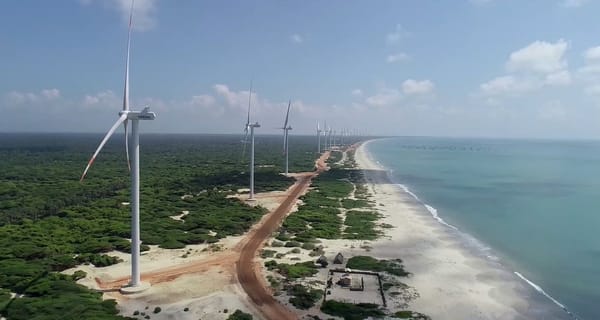Sri Lanka: Where Coal Gets Love and Windmills Get Hate
In Mannar, people — sadly swayed by calculated misinformation and a carefully packaged malicious agenda — once again poured into the streets to protest the windmill project. Curious about the logic behind this opposition, I asked my correspondent to call Mannar MP Selvam Adaikalanathan and bluntly inquire why he was against it. Of the many reasons he rattled off, one stood out for sheer originality — and sheer absurdity: “These windmills will make noise, and it may disturb our children’s studies.”
Yes, dear readers, they can go to any length to justify their opposition — even serving up reasons so silly and laughable that you don’t know whether to chuckle or cry.
Even President Anura Kumara Dissanayake – who, sadly, has no time to meet the parents of disappeared children – somehow found time, in the midst of a packed schedule, to sit down with Mannar’s environmental crusaders. After discussions with Tamil parliamentarians and local representatives, he ordered the project paused for a month to “hear them out.”
And so, Sri Lanka maintains its baffling world record: we are perhaps the only nation where citizens will stand guard over the dirtiest, most poisonous forms of electricity generation, yet form human chains to block projects that could clean our air, slash our bills, and actually secure our future. Coal and diesel plants – the industrial chimneys of death – spew toxins into our skies, foul our waters, and quietly sign our children up for a climate catastrophe, all without triggering much mass protest. But whisper “wind farm” or “solar park” and suddenly the streets overflow with outrage, banners, and petitions.
We seem hell-bent on defending the smokestacks that choke us, while shunning the turbines that could power us into a cleaner, cheaper, and more secure future. Renewable energy carries perhaps one-ten-thousandth the environmental cost of our fossil-fuel addiction – yet here it is, treated as the greater evil.
Ironically, all this unfolded in the same month Sri Lanka officially allocated 64 acres in Mirigama to foreign investors for the cultivation of cannabis for export. I won’t criticise it – a country still on its economic knees must use every legal avenue to rise again – and frankly, it’s better to grow ganja than remain in perpetual meltdown.
And there’s a historical irony worth noting. This government, led by a once-fierce JVP – the same movement that in the 1980s condemned President Premadasa’s UNP for opening the country to garment factories as “stitching underwear for foreigners” – has now embraced the foresight to back industries it once mocked. In hindsight, that garment industry turned out to be one of Sri Lanka’s few post-1977 economic success stories, generating over US$5 billion annually in export earnings and employing nearly one million people directly and indirectly.
The Wind They Fight, the Storm They Ignore
You don’t need a degree in rocket science to see that the protests against the Mannar wind power project are driven by far more than mere “concern for the environment.” They have a personal agenda. For decades, the de facto rulers of Mannar — the Church and its entrenched network of influence (yes, its mafia) — have dictated what happens in the district. They decide who gets elected. They shape how people live. During the war, the Church acted like a willing henchman for the LTTE; today, it is instigating people against any project that might bring long-term benefit to the community. How can we call this democracy when an entire region is held hostage to the will of one institution?
And let’s not forget: along with Negombo and other coastal hotspots, Mannar is a prime point for much of the illegal drug trade that is destroying our youth. Ironically, if the people behind these protests put even one-hundredth of the energy they pour into blocking wind turbines into fighting the drug menace, it would have been stopped or at least drastically curtailed by now. But they won’t — because that fight doesn’t serve their agenda.
Sri Lanka’s Power Crisis: High Costs, Dirty Energy, and Economic Pain
To understand why the Mannar wind project is a godsend, we first need to take a hard look at how Sri Lanka keeps the lights on today. A massive share of our electricity still comes from thermal power – burning imported coal and oil – with hydropower and a token sliver of renewables thrown in. This mix is both economically ruinous and environmentally suicidal. In 2022, we learned that lesson in the most humiliating way possible: the country literally ran out of dollars to buy coal and diesel. We plunged into rolling blackouts, factories fell silent, children studied by candlelight, and total power generation dropped by 4.6% in a single year – simply because our fuel shipments stopped coming.
Even when we can buy fuel, it costs a king’s ransom. The Ceylon Electricity Board’s own figures show that in 2023 the average fuel cost for thermal power shot up to nearly LKR 39 per kWh – several times higher than wind or hydro. Oil-fired plants in particular churn out the most expensive electrons on the grid, often costing dozens of rupees per unit, and CEB has had to beg for emergency diesel generation just to keep the grid from collapsing. The bill lands squarely in your hands: electricity tariffs have been hiked sharply to keep CEB afloat, and the average household now pays LKR 28–30 per kWh – among the highest in the region.
And the environmental bill? Even worse. Take the Norochcholai coal power plant – hailed by some as “cheap” electricity. Cheap on paper, yes; but once you factor in externality costs – the health crises, the poisoned air and water – it becomes the country’s single most expensive indulgence. An expert study found Norochcholai’s social and environmental cost to be a jaw-dropping LKR 36.6 billion a year, the highest of any plant in Sri Lanka. That’s Rs. 10.23 per kWh in hidden costs – from greenhouse gases, sulfur and nitrogen oxides, to the fine particulate matter that lodges deep in our lungs. These toxins cause respiratory disease, heart problems, and crop failures. Farmers and fishermen in its shadow lose over LKR 2 billion annually in reduced yields and destroyed livelihoods.
And if that doesn’t speak to the Sinhala policymakers who keep the coal fires burning, maybe this will: your sacred Sri Maha Bodhi tree – the oldest historically documented tree in the world – has been reported at risk from acid rain caused by Norochcholai’s emissions. Yes, even a national treasure is slowly being etched away by the fumes of “cheap” power.
Enough Smoke – It’s Time to Catch the Wind
Put simply, Sri Lanka’s electricity model is a sick joke – economically unsustainable, environmentally destructive, and morally bankrupt. We are paying through the nose to poison ourselves, to heat the planet, and to endanger our own heritage. And where are the environmental warriors who fill the streets against wind power projects?
Continuing down the fossil-fuel path is not an option – no country with even a shred of logical governance would do it. Right now, the Ceylon Electricity Board is staring at a base capacity shortfall of around 300 MW and is plugging the gap with emergency power purchases at outrageous rates. Those costs don’t vanish into thin air – they come straight back to you and me in the form of crippling power bills.
This year, a severe drought has hammered our hydropower output, and unless the skies open soon, blackouts are not a distant threat – they’re a near certainty. The government, to its credit, pledged back in 2021 that no new coal plants would be built. So, let’s apply some basic logic: if we can’t expand coal, if oil is bleeding us dry, and if hydro is hostage to the weather – what exactly is left?
The answer is obvious to anyone not blinded by politics or petty agendas: rapidly scale up renewable energy. And when it comes to wind, there is no site in Sri Lanka as rich, consistent, and proven as Mannar.
The Lifeline We’re Throwing Away in Mannar
Mannar Island, perched on Sri Lanka’s northwestern tip and staring straight into the Indian Ocean, is blessed with some of the strongest and most consistent winds in all of South Asia. Year-round gusts – supercharged during the monsoon – sweep across its flat, open landscape, offering an energy yield that beats even well-known wind zones like Puttalam. It’s no accident Mannar was chosen for Sri Lanka’s first major wind farm: the 103.5 MW Thambapavani Wind Farm, commissioned in 2020.
That project – 30 sleek Vestas turbines, largely funded by the asian development bank – blew away any doubts. With a plant factor over 40% (world-class by wind standards), it produced 380–400 GWh annually, slashing carbon emissions by more than 265,000 tonnes each year. In just three years, the CEB-run farm has generated over 1.1 billion kWh, reliably pumping cheap, clean electricity into the grid and cutting the need for costly oil-fired generation.
And the economics? Devastatingly in wind’s favour. Recent bids for Mannar wind power have come in below 5 US cents per kWh (about LKR 15 or less). The government says the new Mannar installations will produce at about LKR 13 per unit – half the price of the controversial earlier deal, and a fraction of the LKR 39+ it costs to generate from imported thermal fuel.
Let that sink in: Rs. 13 versus Rs. 39+. Even without adding coal’s massive hidden health and environmental costs, Mannar wind is three times cheaper than the average fuel-based unit. A 300 MW wind farm – the planned Mannar expansion – could save Sri Lanka tens of billions of rupees every year in fuel costs. That’s money that could ease inflation, make electricity affordable for homes and factories, and give our economy a fighting chance. It’s literally the difference between recovery and continued economic collapse.
And the benefits go far beyond the price tag. Wind energy is immune to fuel price shocks – no more panicking when global oil prices spike or when our currency takes a beating. It uses zero water (coal plants swallow millions of litres from our coasts and aquifers), emits no pollution in operation, and has a tiny land footprint once built. Mannar’s expansion could also stabilise the northern grid, attract ancillary industries like turbine maintenance hubs and component assembly, and even provide direct local benefits. Around the world, wind farms share royalties with nearby communities or offer ownership stakes – Mannar could do the same.
Given these facts, it’s no exaggeration to say that opposing the Mannar wind project is national self-sabotage. Yet oppose it, some do – loudly, relentlessly, and with a passion they never seem to find when it comes to fighting coal smoke or diesel fumes. The question is: who are they, what exactly are they fighting for, and how much truth is there in their arguments?
The Protests in Mannar: Environmental Concerns or Economic Myths?
The opposition to the Mannar wind project comes wrapped in the language of environmental and social concern – birds, fish, wetlands, flooding, transparency. Of course, some of these issues are legitimate. A Ramsar wetland needs protection; fishermen deserve to have their livelihoods safeguarded; drainage flaws should be fixed; and EIAs must be thorough and transparent. If all due process is followed, none of these challenges are insurmountable.
But rejecting the project outright? That’s where the mask slips. Around the world, wind farms in sensitive areas operate successfully with mitigation – bird radars, turbine shutdowns during peak migrations, adjusted layouts, community benefit schemes. Mannar could do the same. What’s unfolding instead is a campaign of exaggerated fears and half-truths, driven less by love of the environment and more by entrenched politics and hidden agendas.
Genuine concerns can be addressed. Manufactured outrage should not be allowed to sabotage national progress.
The Hidden Agenda: Who’s Really Behind the Opposition?
It’s an uncomfortable but necessary question: who actually stands to gain from killing Sri Lanka’s push into wind energy? And are the loudest voices against the Mannar project truly driven by concern for birds and fishermen – or are there deeper political, economic, and geopolitical motives at play?
Some in Mannar opposed the earlier plan simply because it involved an Indian company – Adani. That debate ended when the government scrapped the deal. But the damage didn’t stop there. In business circles, it sent a chill through the investment climate: if a conglomerate as large and politically connected as Adani could be forced out, what confidence would smaller Indian firms have in bringing capital here? A serious study could likely show how that single withdrawal dented Sri Lanka’s economic prospects by making the island appear hostile or unreliable to certain investors.
That said, the Adani deal itself was far from perfect. The negotiated tariff was widely criticised as being on the high side, with limited local participation and clauses that gave the company an unusually strong position over a key national asset. These flaws were valid reasons to renegotiate or seek better terms. And that is precisely what happened – the current proposal is from HayWind One Limited, a fully Sri Lankan-owned subsidiary of Hayleys Fentons, awarded through a competitive tender at just 4.65 US cents per kWh – far below fossil fuel generation costs.
So here’s the question: if the rallying cry was “No to Adani,” why does the opposition remain when the developer is now a home-grown company, offering cleaner, cheaper power?
This is where a broader global pattern comes into view – one that some analysts bluntly call the international NGO circuit. Across the developing world, well-funded networks often lend support to local protests under the banners of “environment” or “human rights.” Yet somehow, the projects that draw their fiercest resistance are those that clash with certain foreign geopolitical or economic interests.
India has seen this before. The Kudankulam nuclear plant protests, once hailed as “grassroots,” later turned out to have been energised by NGOs receiving most of their funding from abroad – some even paying villagers to join demonstrations and coordinating with international activist groups. The Indian government revoked licences, exposed internal messages, and documented a clear strategy to stall energy projects under the guise of local opposition.
This is not to say every group in Mannar is acting in bad faith. But the anti-wind campaign has enjoyed unusual international amplification. Environmental NGOs like the Centre for Environmental Justice (CEJ) and the Wildlife and Nature Protection Society are linked into global conservation networks that provide funding, media support, and legal expertise. To think these ties have no influence on strategy or narrative would be naïve.
Even the Catholic Church’s involvement has an international dimension. Its environmental advocacy draws from Pope Francis’s Laudato Si’, and dioceses often work closely with international Catholic charities. In a post-war region where the Church’s influence is profound, it’s reasonable to ask whether overseas partners – with their own ideological leanings – have encouraged the Mannar Diocese to take such a hardline position.
The result is something that feels less like a purely local cause and more like a local front plugged into a global machine. The Diocese has rarely mobilised with this intensity over development issues, yet here it is, working alongside Colombo-based environmental experts in legal challenges that echo certain Global North narratives: that developing nations must freeze large-scale projects in the name of conservation, even when those projects deliver clean energy.
This skirts dangerously close to climate colonialism. Europe blankets its landscape with turbines – Denmark gets over 50% of its electricity from wind, the UK 28%, and India has more than 40 GW spinning away, including over 10 GW in Tamil Nadu alone – yet complaints about bird strikes or fishing impacts rarely make global headlines. Put those same turbines in the Global South, backed by non-Western or even domestic investors, and suddenly the outrage is deafening.
Closer to home, the selectivity is glaring. Where is the outcry against illicit sand mining that truly ravages coastlines? Or the ilmenite mining project, where evidence emerged of locals being paid to stage support rallies? Mannar’s development battles are drenched in politics, money, and influence – to the point where genuine environmental concerns risk being drowned out by manufactured protest.
Let’s Not Mince Words: This is National Self-Sabotage
Opposing the Mannar wind project, at this point in Sri Lanka’s economic and energy freefall, is not just misguided – it’s reckless. It condemns the entire country to keep paying ruinous electricity bills, breathing poisoned air, and bleeding foreign exchange, all to “preserve” one island in aspic.
And for what? The anti-wind leaders offer no credible alternative to meet our looming power shortfall. What’s the plan – build more diesel generators? Burn more coal, driving up greenhouse gases and acid rain (which does far more damage to bird migrations and fish stocks than a few turbines ever could)? Import electricity from India – which could well come from India’s own wind farms or dirty coal plants – and pay even more for it?
It would be laughable if the consequences weren’t so destructive. Wrapped in the language of “justice” and “conservation,” the movement is in practice perpetuating injustice against 22 million Sri Lankans who need clean, affordable, reliable power – and locking us into the very fossil-fuel dependence that causes the environmental damage they claim to oppose.
Politics in the Guise of Principle
There’s also an unmistakable political scent here. Some protest figures have long-standing grudges against the government – past and present – and an anti-corporate, anti-“big project” crusade is a convenient rallying cry. Let’s be honest: if this project had been proposed under a rival administration, the current JVP-led government’s allies would almost certainly have opposed it to the hilt. In Sri Lanka, energy policy often boils down not to engineering, but to electoral calculus.
The Northern Province, with its history of alienation from Colombo, provides fertile ground for such positioning. Certain politicians have seized the wind farm as a chance to paint themselves as champions of “people’s rights” against the central government or foreign investors. It’s telling that all Tamil MPs from Mannar and Vanni signed a letter demanding the project’s halt. Did they also submit a concrete plan to generate the hundreds of megawatts the north and country will soon need? Not that we’ve seen. It’s far easier to boast “we stopped a bad deal” than to take responsibility for keeping the lights on.
A Divisive and Dangerous Narrative
Meanwhile, many ordinary people in Mannar are being sold a false choice – as if feeding electricity into the national grid is something that benefits “others” while locals carry all the costs. The truth? The north stands to gain enormously from modern power infrastructure:
- Jobs and industry – factories won’t invest in a region with chronic outages and voltage drops.
- Economic stability – cheaper, cleaner energy keeps household and business costs down.
- Community development – global examples show wind farms often support local projects, infrastructure, or royalties.
- Even tourism – yes, in some countries, wind farms have become attractions in their own right.
This is the part the protest leaders won’t say: blocking Mannar’s wind project is not a victory for the people – it’s a victory for high electricity prices, power cuts, imported fuel dependency, and the status quo that keeps the north economically stagnant.
What Needs to Happen – Now
- Approve the project with stronger safeguards. Finish any extra environmental checks openly. Add modern bird radars, seasonal shutdowns during peak migration, and habitat offsets like upgraded wetlands. Space turbines smartly to leave bird flyways clear. Development and conservation can coexist – the rest of the world already does it.
- Make the community a partner, not a bystander. Guarantee local jobs and training. Set up a community trust funded by project revenue for Mannar’s schools, clinics, and fishing industry. Compensate and assist any fishermen directly affected. When locals see real benefits, the fight changes from “their project” to “our project.”
- Address genuine issues fast and openly. If flooding or damage occurs, fix it immediately and fairly. Publish all monitoring data, and let independent experts – even critics – sit on the oversight committee. Turn suspicion into trust through transparency.
- Destroy the misinformation with facts. In Tamil, Sinhala, and English, show what the project really means. Compare it honestly to the alternatives: more diesel plants, more coal, higher bills, and worse climate damage. Show examples worldwide where wind power works without wrecking communities.
- Uphold the law once the process is complete. Protest is a right – obstruction is not. Once the legal boxes are ticked, the project must move forward. If certain actors keep blocking unlawfully, follow the money and ask why. No small group – especially one backed by outside agendas – should hold 22 million people hostage to stagnation.
Embracing the Future: Catching the Wind Before It Passes Us By
Around the globe, nations are racing toward renewables. Even oil kingdoms like the UAE and Saudi Arabia are investing heavily in wind and solar because they know the fossil era is ending. Are we really going to stay stuck in the 20th century, burning fuel we can’t afford, living with rationed power, and borrowing money just to keep the lights on – all because some want to turn a few turbines into the enemy? That’s not caution; that’s national negligence.
If Sri Lanka cannot find the courage to embrace the wind that could save it, then we will deserve the darkness that follows.
கணியன் பூங்குன்றன்
Kaniyan Pungundran
Editor-in-Chief,
Jaffna Monitor







